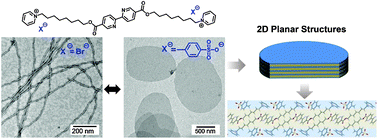Controlling the self-assembly of cationic bolaamphiphiles: counterion-directed transitions from 0D/1D to exclusively 2D planar structures†
Abstract
Self-assembly of cationic bolaamphiphiles is usually reported to form one-dimensional (1D) or zero-dimensional (0D), rather than two-dimensional (2D) structures. Here we have found a facile counterion-directed structure switch for such amphiphilic moieties. 0D/1D structures formed by self-assembly of cationic bolaamphiphiles can be converted into 2D planar structures by a simple counterion change to tosylate. As indicated by the single crystal structure and variable-temperature NMR studies, the strong binding between tosylate counterions and cationic headgroups drives the formation of 2D planar structures. It is highly anticipated that this approach may present as a simple methodology to control the stacking of the embedded conjugated cores in bolaamphiphiles, therefore modulating optoelectronic properties and function in such assemblies.


 Please wait while we load your content...
Please wait while we load your content...